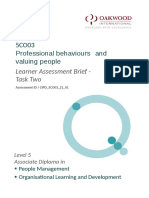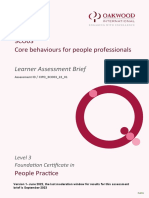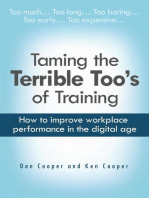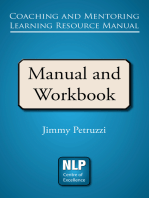qx6e83foflga-5CO03Brief24 012
Uploaded by
Kibet Elishaqx6e83foflga-5CO03Brief24 012
Uploaded by
Kibet Elisha5CO03
Professional behaviours
and valuing people
Learner Assessment Brief
Assessment ID / CIPD_5CO03_24_01
Level 5 Associate Diploma in
• People Management
• Organisational Learning and Development
• Version 1 – Released June 2024
• Expires June 2025
• Study Centre information only: Last moderation window is September 2025
Level 5 Associate Diploma
5CO03
Professional behaviours and
valuing people
This unit focuses on how applying core professional behaviours such as ethical practice, courage
and inclusivity can build positive working relationships and support employee voice and well-
being. It considers how developing and mastering new professional behaviours and practice can
impact performance.
CIPD’s insight
HR and standards (December 2022)
This factsheet explains what British and International standards in HR are and why they matter. It
introduces the British and International HR standards already published or under development and
outlines the CIPD involvement in their development. Whether or not organisations have a
dedicated HR team, they will at some point need guidance on ethical and effective human
resource management practice in areas such as workforce planning, recruitment, inclusion and
diversity, learning and development, and human capital reporting. British and International
standards provide such guidance. International experts develop them, in collaboration with key
stakeholders. These standards advocate responsible people management practices and support the
organisations that adopt them to improve their organisational resilience and sustainability.
https://www.cipd.co.uk/knowledge/strategy/hr/standards-factsheet
Equality, diversity and inclusion (EDI) in the workplace (November 2022)
Promoting and delivering EDI in the workplace is an essential aspect of good people management.
To reap the benefits of EDI, it’s about creating working environments and cultures where every
individual can feel safe, a sense of belonging and is empowered to achieve their full
potential. Whilst legal frameworks vary across different countries, in the UK the Equality Act 2010
provides legal protection for nine protected characteristics: age, disability, gender reassignment,
marriage and civil partnership, pregnancy and maternity, race, religion or belief, sex and sexual
orientation. However, an effective EDI strategy goes beyond legal compliance and seeks to take
an intersectional approach adding value to an organisation, contributing to the wellbeing and
equality of outcomes and impact on all employees. This includes: accent, age, caring
responsibilities, colour, culture, visible and invisible disability, gender identity and expression,
mental health, neurodiversity, physical appearance, political opinion, pregnancy and
maternity/paternity and family status and socio-economic circumstances amongst other personal
characteristics and experiences. This factsheet explores what workplace equality inclusion and
diversity (EDI) means, and how an effective strategy is essential to an organisation’s business
objectives. It looks at the rationale for action and outlines steps organisations can take to
implement and manage a successful EDI strategy, from recruitment, selection, retention,
communication and training to addressing workplace behaviour and evaluating progress.
https://www.cipd.co.uk/knowledge/fundamentals/relations/diversity/factsheet#6428
Ethical practice and the role of people professionals (November 2023)
Version 1 - Released June 2024
2
Level 5 Associate Diploma
Scandals involving workplace harassment and poor treatment of workers have highlighted what
can happen when ethics aren’t integral to the way an organisation operates. Having unique access
to staff and opportunities to influence an organisation’s strategy and the way it manages its
workforce; people professionals are uniquely placed within an organisation. They can support the
embedding of principled decision-making into daily practice. Ethics are at the heart of
professionalism. To create cultures of transparency and trust, practitioners should demonstrate
strong standards of integrity when advising business leaders.
This factsheet explores what ethical practice means and why it matters in an organisational
context. It outlines the trade-offs involved in upholding ethical values and the challenges faced by
people professionals. Finally, it looks at the profession’s role in creating ethical organisational
cultures.
https://www.cipd.org/uk/knowledge/factsheets/ethics-role-hr-factsheet/
Ethics at work: an employer’s guide (February 2024)
Ethical values provide the moral compass by which we live our lives and make decisions: ‘doing
the right thing’ because it’s the right thing to do. However, there are several reasons why
unethical behaviour continues to happen in the workplace, from individual actions and choice to
industry-wide indiscretions and compromising decisions.
In this guide, we discuss the red flags to watch out for, along with practical tips and resources to
safeguard your organisation and people against ethical breaches and misconduct. The guide draws
on – and complements – the latest CIPD research, and features nine areas of action employers can
prioritise to ensure they behave ethically. If you’re an employer or manager looking to foster and
encourage ethical behaviour in your organisation, you’ll find the practical advice you need in this
guide.
https://www.cipd.co.uk/knowledge/culture/ethics/ethics-work-guide
Please note that the purpose of this insight is to link you to CIPD’s research and evidence within the subject
area, so that you can engage with the latest thinking. It is not provided to replace the study required as
part of the learning or as formative assessment material.
Version 1 - Released June 2024
3
Level 5 Associate Diploma
Preparation for the Tasks:
• At the start of your assessment, you are encouraged to plan your work with your assessor
and where appropriate agree milestones so that they can help you monitor your progress.
• Refer to the indicative content in the unit to guide and support your evidence.
• Pay attention to how your evidence is presented.
• Ensure that the evidence generated for this assessment remains your own work.
You will also benefit from:
• Completing and acting on formative feedback from your assessor.
• Reflecting on your own experiences of learning opportunities and continuous professional
development.
• Reading the CIPD Insight, Fact Sheets and related online material on these topics as well as
key research authors on the subject.
Version 1 - Released June 2024
4
Level 5 Associate Diploma
Task –Professional and ethical behaviours
This assessment, like the unit it is based on, considers some key professional and ethical
behaviours that are expected of a people practice professional.
The assessment requires you to demonstrate, in written responses, your knowledge and abilities
against each of these requirements. To assist you to do this, the assessment poses 11 questions,
one for each of the requirements.
You should respond to each of the 11 questions, providing a mix of theoretical knowledge,
practical examples and personal reflection as required. Some of the questions ask you to include
feedback from others, and so before you commence this assessment you are advised to identify
and collect relevant feedback from at least one other person who has an insight into your
behaviour at work. You will also need to set up some continued professional development (CPD)
documentation if you do not have this already.
When submitting your responses, please ensure that these are clearly signposted typically using
sub-headings or question numbers and AC references to link your responses to the relevant
question. You should also ensure that your work complies with the wordcount requirements stated
at the end of this assessment brief.
Please respond to all 11 questions below:
An effective people practice professional will:
1. Understand the purpose and value of the people profession.
Q: With reference to the CIPD Profession Map, appraise what it means to be a people
professional. (AC 1.1)
2. Know own personal and ethical values and apply these consistently in their (people
practice) work.
Q: Discuss your personal and ethical values (one of each), with examples of how these are
evident in your work. (If you have yet to work in people practice, explore how you believe
your values would inform your work.) (AC 1.2)
3. Know the importance of people professionals contributing to discussions in an
informed, clear and confident way to influence others.
Q: Discuss reasons why this is important and the consequences of people practitioners not
being willing or able to influence others. (AC 1.3)
4. Know when and how to raise matters that might be unethical or illegal.
Q: Discuss, with examples, when and how you would react to both unethical and illegal
matters (one of each). (AC 1.4)
5. Be able to make use of related theory and thinking, to argue the human and business
benefits of people feeling included, valued, and fairly treated at work.
Q: Demonstrate your ability to do this with a written argument, which poses different
theoretical perspectives, as well as your own. (AC 2.1)
Version 1 - Released June 2024
5
Level 5 Associate Diploma
6. Know how to design people practice initiatives to be inclusive and how to check
inclusivity after an initiative has been implemented.
Q: Discuss, with examples, how you have, or would, achieve both of these (AC 2.2)
7. Be able to work inclusively with others and build positive working relationships.
Q: Using a combination of your own reflections and feedback from at least one other
person, discuss your ability to work inclusively and positively with others. (AC 2.3)
There is no requirement to include evidence of the use of references to wider reading for
AC 2.3
8. Understand how the people practitioner role is evolving and the implications this has
for your ongoing professional development.
Q: Demonstrate your understanding of this with a written response and related entries in
your CPD Plan. (AC 3.1)
9. Be able to assess (own) strengths, weaknesses and development areas, based on own
considerations and feedback from others.
Using a combination of your own conclusions and feedback from at least one other person,
assess yourself against a specification of your choice (such as a role/job description or any
two of the core behaviour areas of the CIPD Profession Map (associate level). Briefly
explain the outcome of your assessment (strengths, weaknesses and development areas)
and the information that informed your conclusions. (AC 3.2)
There is no requirement to include evidence of the use of references to wider reading for
AC 3.2
10. Be able to formulate a range of appropriate CPD options to support ongoing learning.
Following on from your self-assessment, identify a range of formal or informal
development activities and add these to your CPD Plan/document. Provide a brief
explanation as to why you have selected these activities. (AC 3.3)
There is no requirement to include evidence of the use of references to wider reading for
AC 3.3
11. Be able to reflect on and draw conclusions about the effectiveness of development
activities.
Reflect on three development activities, already undertaken, that have had an impact on
your work behaviour or performance, explaining how they have impacted you. (Your
reflections should be presented within your CPD Record document.) (AC 3.4)
There is no requirement to include evidence of the use of references to wider reading for
AC 3.4
TASK
Your evidence must consist of:
• Written responses to questions 1-10
(Approximately 3250 words in total, refer to CIPD word count policy)
• A CPD Plan/Record document, format as preferred, edited to provide just the required
information for Qs 8, 10 & 11. (Not included in word count)
Version 1 - Released June 2024
6
Level 5 Associate Diploma
Assessment Criteria Evidence Checklist
You may find the following checklist helpful to make sure that you have included the required
evidence to meet the task. This is not a mandatory requirement as long as it is clear in your
submission where the assessment criteria have been met.
Task – Professional and ethical behaviours.
Evidenced
Assessment criteria Evidence reference
Y/N
1.1 Appraise what it means to be a people
professional.
1.2 Recognise how personal and ethical
values can be applied in the context of
people practice.
1.3 Consider the importance of people
professionals contributing to discussions
in an informed, clear and confident way
to influence others.
1.4 Recognise when and how you would
raise matters which conflict with ethical
values or legislation.
2.1 Argue the human and business benefits
of people feeling included, valued, and
fairly treated at work linking to related
theory.
2.2 Discuss strategies for designing and
ensuring inclusive people practices.
2.3 Reflect on your own approach to
working inclusively and building positive
working relationships with others.
3.1 Explore how the role of a people
professional is evolving and the
implications this has for continuing
professional development.
3.2 Assess your strengths, weaknesses and
development areas based on self-
assessment and feedback from others.
Version 1 - Released June 2024
7
Level 5 Associate Diploma
Task – Professional and ethical behaviours.
Evidenced
Assessment criteria Evidence reference
Y/N
3.3 Formulate a range of formal and/or
informal continuing professional
development (CPD) activities to support
your learning journey.
3.4 Reflect on the impact of your continuing
professional development activities on
own behaviour and performance.
Version 1 - Released June 2024
8
Level 5 Associate Diploma
5CO03
Professional behaviours and
valuing people
Assessment Criteria marking descriptors.
Assessors will mark in line with the following assessment criteria (AC) marking descriptors, and
will indicate where the learner sits within the marking band range for each AC.
Assessors must provide a mark from 1 to 4 for each assessment criteria within the unit. Assessors
should use the mark descriptor grid as guidance so they can provide comprehensive feedback that
is developmental for learners. Please be aware that not all the mark descriptors will be present in
every assessment criterion, so assessors must use their discretion in making grading decisions.
The grid below shows the range for each unit assessment result based on total number of marks
awarded across all assessment criteria.
To pass the unit assessment learners must achieve a 2 (Low Pass) or above for each of the
assessment criteria.
The overall result achieved will dictate the outcome the learner receives for the unit, provided
NONE of the assessment criteria have been failed or referred.
Please note that learners will receive a Pass or Fail result from the CIPD at unit level. Referral
grades can be used internally by the centre.
Overall mark Unit result
0 to 21 Fail
22 to 28 Low Pass
29 to 35 Pass
36 to 44 High Pass
Version 1 - Released June 2024
9
Level 5 Associate Diploma
Marking Descriptors
Mark Range Descriptor
1 Fail The response DOES NOT demonstrate sufficient knowledge,
understanding or skill (as appropriate) to meet the AC.
Insufficient examples included where required to support answer.
Insufficient or no evidence of the use of wider reading to help
inform answer.
Presentation or structure of response is not appropriate and does
not meet the requirement of the question/assessment brief.
2 Low Pass The response demonstrates an acceptable level of knowledge,
understanding or skill (as appropriate) to meet the AC.
Sufficient acceptable examples included where required to support
answer.
* Sufficient evidence of appropriate wider reading to help inform
answer. Satisfactory in-text referencing.
Answer is acceptable but could be clearer in responding to the
question/task and presented in a more coherent way.
Required format adopted but some improvement required to the
structure and presentation of the response.
3 Pass The response demonstrates a good level of knowledge,
understanding or skill (as appropriate) to meet the AC.
Includes confident use of examples, where required to support the
answer.
* Good evidence of appropriate wider reading to help inform
answer. A good standard of in-text referencing.
Answer responds clearly to the question/task and is well expressed.
Presentation and structure of response is appropriate for the
question/task.
4 High Pass The response demonstrates a wide and confident level of
knowledge, understanding or skill (as appropriate) to meet the AC.
Includes strong examples that illustrate the points being made and
support the answer.
*Considerable evidence of appropriate wider reading to inform
answer. An excellent standard of in-text referencing.
Answer responds clearly to the question/task and is particularly well
expressed or argued.
Presentation and structure of response is clear, coherent, and
responds directly to the requirements of the question/task.
* Evidence of wider reading is an important feature of assessments
at this level. However, whilst a good and appropriate level of this
should be seen across the assessment, there is no requirement for
references to appear within every AC response. The following AC(s)
do not require referencing: AC 2.3, AC 3.2, AC 3.3 and AC 3.4.
Version 1 - Released June 2024
10
You might also like
- ITIL® 4 Direct, Plan and Improve (DPI): Your companion to the ITIL 4 Managing Professional and Strategic Leader DPI certificationFrom EverandITIL® 4 Direct, Plan and Improve (DPI): Your companion to the ITIL 4 Managing Professional and Strategic Leader DPI certificationNo ratings yet
- 5CO02 Evidence-Based Practice - June 20241No ratings yet5CO02 Evidence-Based Practice - June 2024115 pages
- Ontearning: Audrey Osler and Hugh StarkeyNo ratings yetOntearning: Audrey Osler and Hugh Starkey168 pages
- 5CO03 - Assessment Brief and MarkSheet OCT 22No ratings yet5CO03 - Assessment Brief and MarkSheet OCT 2221 pages
- CIPD Profession-Map - Full-Standards-DownloadNo ratings yetCIPD Profession-Map - Full-Standards-Download29 pages
- Profession Map Full Standards November 2023No ratings yetProfession Map Full Standards November 202329 pages
- 3CO03 Core Behaviours For People Professionals: Learner Assessment BriefNo ratings yet3CO03 Core Behaviours For People Professionals: Learner Assessment Brief17 pages
- 3CO03 Core Behaviours - ASSESSMENT GUIDE - Feb 2021No ratings yet3CO03 Core Behaviours - ASSESSMENT GUIDE - Feb 202112 pages
- 5CO02 Evidence-Based Practice: Learner Assessment Brief - Task OneNo ratings yet5CO02 Evidence-Based Practice: Learner Assessment Brief - Task One8 pages
- Application For An Offshore Humanitarian VisaNo ratings yetApplication For An Offshore Humanitarian Visa34 pages
- Professional Behaviours and Valuing PeopleNo ratings yetProfessional Behaviours and Valuing People28 pages
- ECAREERS June 2024 - 3CO03 Core Behaviours for People ProfessionalsNo ratings yetECAREERS June 2024 - 3CO03 Core Behaviours for People Professionals14 pages
- Professional Behaviors and Valuing PeopleNo ratings yetProfessional Behaviors and Valuing People16 pages
- 0jq3460fgl4y-5CO03AssessmentSession22 V22No ratings yet0jq3460fgl4y-5CO03AssessmentSession22 V2225 pages
- J7apic8ntlrk NEW5CO02Evidence Basedpractice June20221No ratings yetJ7apic8ntlrk NEW5CO02Evidence Basedpractice June2022118 pages
- Learner Assessment Brief - CIPD - 5CO02 - 23 - 01No ratings yetLearner Assessment Brief - CIPD - 5CO02 - 23 - 0116 pages
- Core Behaviours For People Professionals 3CO03 Abdulaziz Alaql 11No ratings yetCore Behaviours For People Professionals 3CO03 Abdulaziz Alaql 1113 pages
- Measuring ROI in Learning & Development: Case Studies from Global OrganizationsFrom EverandMeasuring ROI in Learning & Development: Case Studies from Global OrganizationsNo ratings yet
- Matt Gofton Senior Employer Engagement Manager 07525101339: M.gofton@cipd - Co.ukNo ratings yetMatt Gofton Senior Employer Engagement Manager 07525101339: M.gofton@cipd - Co.uk27 pages
- 5HR01 Employment Relationship Management Abdullah AlAmriNo ratings yet5HR01 Employment Relationship Management Abdullah AlAmri32 pages
- Learner Assessment Brief - CIPD - 5CO01 - 23 - 01No ratings yetLearner Assessment Brief - CIPD - 5CO01 - 23 - 0114 pages
- Coaching for Action: A Report on Long-term Advising in a Program Context: A Report on Long-term Advising in a Program ContextFrom EverandCoaching for Action: A Report on Long-term Advising in a Program Context: A Report on Long-term Advising in a Program ContextNo ratings yet
- Outcome-Based Experiential Learning: Let's Talk About, Design For, and Inform Teaching, Learning, and Career DevelopmentFrom EverandOutcome-Based Experiential Learning: Let's Talk About, Design For, and Inform Teaching, Learning, and Career DevelopmentNo ratings yet
- The Encyclopedia of Human Resource Management, Volume 3: Thematic EssaysFrom EverandThe Encyclopedia of Human Resource Management, Volume 3: Thematic EssaysNo ratings yet
- The Specialist Pipeline: Winning the War for Specialist TalentFrom EverandThe Specialist Pipeline: Winning the War for Specialist TalentNo ratings yet
- Unlocking Your Potential Through Talent Development and Professional GuidanceFrom EverandUnlocking Your Potential Through Talent Development and Professional GuidanceNo ratings yet
- Unfolding: How biographical inquiry informs meaning-making in coaching psychologyFrom EverandUnfolding: How biographical inquiry informs meaning-making in coaching psychologyNo ratings yet
- Becoming a Reflective Practitioner: The Reflective Ethical Facilitator's GuideFrom EverandBecoming a Reflective Practitioner: The Reflective Ethical Facilitator's GuideNo ratings yet
- The Leadership Habit: Transforming Behaviors to Drive ResultsFrom EverandThe Leadership Habit: Transforming Behaviors to Drive ResultsNo ratings yet
- CPD 1 - Code of Professional Conduct & Ethical Standards100% (1)CPD 1 - Code of Professional Conduct & Ethical Standards61 pages
- Taming the Terrible Too's of Training: How to improve workplace performance in the digital ageFrom EverandTaming the Terrible Too's of Training: How to improve workplace performance in the digital ageNo ratings yet
- Three Keys to Development: Defining and Meeting Your Leadership ChallengesFrom EverandThree Keys to Development: Defining and Meeting Your Leadership ChallengesNo ratings yet
- Introduction To Ethics and Excellence in ProfessionNo ratings yetIntroduction To Ethics and Excellence in Profession19 pages
- Common Sense Talent Management: Using Strategic Human Resources to Improve Company PerformanceFrom EverandCommon Sense Talent Management: Using Strategic Human Resources to Improve Company PerformanceNo ratings yet
- MSC 20 Thesis 20 Zsofia 20 Anna 20 Bossanyi 2010090920 FinalNo ratings yetMSC 20 Thesis 20 Zsofia 20 Anna 20 Bossanyi 2010090920 Final103 pages
- Mega American Culture IN A NUTSHELL BY NHNTanNo ratings yetMega American Culture IN A NUTSHELL BY NHNTan31 pages
- CBSE Class 10 Political Science Outcomes of Democracy WorksheetNo ratings yetCBSE Class 10 Political Science Outcomes of Democracy Worksheet14 pages
- PDF (eBook PDF) American Government in Black and White: Diversity and Democracy 4th Edition download100% (1)PDF (eBook PDF) American Government in Black and White: Diversity and Democracy 4th Edition download40 pages
- Factsheet Exam Guide Cuet-Pg Political SC - Pol SC HelpNo ratings yetFactsheet Exam Guide Cuet-Pg Political SC - Pol SC Help358 pages





























































































